- Health Conditions A-Z
- Health & Wellness
- Nutrition
- Fitness
- Health News
- Ayurveda
- Videos
- Medicine A-Z
- Parenting
- Web Stories
Mum Dies Minutes After Routine CT Scan For Toothache She Couldn't Get Treated, Partner Urges Not Delay Health Check-ups

What was supposed to be a routine hospital visit to deal with an persistent toothache resulted in a catastrophic and fatal allergic reaction for County Durham, England's 34-year-old Leigh Rodgers. Leigh went for medical attention early in March 2024 after two weeks of living with unbearable toothache and having trouble finding a dentist appointment. When her pain worsened, spreading to her neck and chest, physicians became worried about a life-threatening, unusual bacterial infection—Ludwig's angina—and had her undergo a CT scan to eliminate it.
Yet, just 90 minutes after the scan, Leigh suffered anaphylactic shock—a catastrophic allergic reaction to the contrast dye administered before the imaging—and sadly died. Her premature death has now raised new debates about patient awareness, risks of contrast dye, and emergency dental care gaps.
What are Contrast Dye Reactions?
CT scans, particularly when employed to evaluate infections or internal injury, usually include injecting a contrast dye. The contrast dye, commonly iodine, makes organs and tissues more visible during the test. While a necessity for making accurate diagnoses, these contrast medications carry a potential for adverse reaction.
Based on numerous medical studies and health warnings, severe allergic responses to contrast medium are seen in less than 1% of patients. While the majority of people can safely take the dye, susceptible persons can have reactions from mild (nausea, skin rash, metallic taste) to severe (difficulty in breathing, hypotension, convulsions).
In Leigh's situation, even though she was never diagnosed with previous dye allergies, her body responded lethally within minutes of contact. The tragedy is not just the reaction but the timing as well—had she received prompt dental attention, the CT scan would never have been required.
Ludwig's angina, as rare as it is, is a serious illness caused by infections from bacteria starting in the mouth or jaw. It can rapidly swell the throat and neck and block the airway. Due to its severity and deadly risk, physicians are usually cautious to the point of overcautiousness if symptoms indicate infection spread as a possibility.
Leigh's symptoms—crescendo pain, edema, and chest pain—paralleled early signs of Ludwig's angina that led to ordering the CT scan. The infection was eventually discounted by the CT scan, yet by this point, the dye had already been injected.
Leigh's tearful mother, Pam Rodgers, has been vocal about what happened to her daughter. She is adamant that the UK's clogged-up dental health care system had something to do with Leigh's fatal accident. "If she'd been able to have a dental appointment, she wouldn't be dead," she said. Pam has also questioned informed consent and whether Leigh was properly informed of the dangers involved in the CT scan.
Her comment reveals something of an oft-forgotten problem—patients receiving diagnostic scans may not always be properly informed about the dangers of contrast agents, particularly in high-pressure emergency environments.
Pam continued, "There's nothing to prevent them from distributing a leaflet to describe the risks… I want people to know about risks associated with contrast media and problems with the NHS."
Leigh's case also highlights an increasing public healthcare crisis: the unavailability of timely access to dental treatment. Her partner gave evidence during the inquest that Leigh had attempted multiple times to obtain a dentist appointment within two weeks but failed because of long waiting lists and system delays.
The inquest concluded that Leigh died from an anaphylactic reaction to contrast dye after attending the hospital for symptoms linked to a suspected tooth abscess. Despite the CT scan revealing no signs of Ludwig’s angina, her allergic reaction progressed too rapidly for intervention.
The County Durham and Darlington NHS Foundation Trust issued a statement of condolences and confirmed that an internal review had been conducted, and the findings had been given to the family. "We are ensuring that the lessons learned from this report are embedded across the trust to improve our services," the statement said.
Warning Signs and What You Need to Know About Contrast Dye Allergies
Although uncommon, reactions to contrast dye cannot be ignored, particularly for those with existing conditions like kidney disease, heart disease, asthma, or allergies. The NHS advises patients to be observed for a minimum of 30 minutes after the scan if contrast is administered. Worrying symptoms are:
- Breathlessness
- Hives or flushing of skin
- Swelling of lips or throat
- Vomiting
- Dizziness or fits
Patients with a history of reaction should always reveal such a history prior to imaging procedures. In others, pre-treatment with corticosteroids or antihistamines can be employed to reduce risks.
Leigh Rodgers' tale is a chilling reminder of how uncommon complications can have devastating consequences. It also underscores the imperative need for improved communication between patients and healthcare providers, particularly for risk disclosures in emergency situations.
This event also supports the need to address systemic shortcomings in first-level healthcare services such as dentistry, where access delays can result in higher-risk, more costly interventions. For patients, it is a reminder to be proactive in asking questions prior to any diagnostic procedure, being aware of possible risks, and being an advocate for themselves when normal care is not available.
In Leigh's memory, her family wishes that this tragedy will spur change—how patients are told things, how soon they can receive critical care, and how infrequent medical risks are disclosed and monitored in real time.
Kerala Student Tests Positive For H1N1, 3 More Showing Symptoms -Top Signs And Symptoms To Note

A Class IX student in Kollam was diagnosed with H1N1 (swine flu) on Wednesday. Reports find that three other students from the same class were reporting fever-like symptoms since July 13 and are now being treated for similar symptoms. Currently, their test results are pending. The health officials will now be screening more students at the school.
H1N1 And Why It Is A Cause of Concern – Signs and Symptoms
H1N1 flu, also called "swine flu," is a very catching virus. It mostly affects your nose and throat, but can sometimes get into your lungs too. If you get H1N1, you might feel sick with things like:
- A runny nose
- Shivers
- Achy muscles
- Headache
- Fever and chills
- Loss of appetite
While it's often a mild illness, it can sometimes cause serious issues in your lungs or stomach. In rare cases, it can even lead to serious breathing trouble or other infections.
This type of flu became a worldwide problem because it was a new mix of pig, bird, and human flu viruses. It spread to millions of people and even affected businesses like food and tourism.
The best way to fight H1N1 is to get antiviral medicine early, within 72 hours of your symptoms starting. This can make the illness less severe and even save lives. Vaccines and other ways to prevent the flu are also super important to stop it from spreading.
If your doctor thinks you have H1N1, they'll test samples from your nose or throat to be sure. Getting the best care, especially for people who are at higher risk, often involves a team of different healthcare professionals working together.
The Rise Of Swine Flu And How It Spreads
The Centre of Disease Control and Prevention explains that swine flu is a highly contagious breathing illness that affect pigs. While it's uncommon for humans to catch swine flu from pigs, it can happen if they are in close contact with infected pigs or places where their viruses are present. Once a person gets infected, they can then spread the virus to other people, likely through coughing or sneezing, just like regular seasonal flu.
How Swine Flu Changes
CDC explains that just like the flu virus that affects people and birds, swine flu viruses are always changing. Pigs are unique because they can catch flu viruses not just from other pigs, but also from birds (avian flu) and people (human flu).
When different types of flu viruses infect a pig at the same time, they can mix and swap their genetic material. This is like shuffling a deck of cards. When they mix, brand new flu viruses can be created that are a combination of swine, human, or avian flu.
Over time, many different kinds of swine flu have appeared. Right now, in the United States, there are three main types of influenza A viruses found in pigs: H1N1, H1N2, and H3N2.
Treating H1N1 – Managing the Disease
According to Medscape, if you have H1N1 flu, the main goal of treatment is to help you feel better. This usually means resting a lot, drinking plenty of fluids, and taking medicines to calm your cough, lower your fever, and ease muscle aches (like Tylenol or ibuprofen). If someone gets very sick, they might need fluids given through a vein and other help from doctors. Sometimes, doctors might also give special antiviral medicines to treat the flu or to keep you from getting it if you've been exposed.
Inspired By 'Breaking Bad' Two Rajasthan Teachers Made Mephedrone, A Synthetic Drug Worth Rs. 15 Crore In Their Home-Lab

Credits: Canva
In Muklawa, Sri Ganganagar district in Rajasthan, nobody even had an idea of what's cooking. Two teachers from a local government school and a physics tutor from a local coaching centre, Manoj Bharghav and Indrijeet Bishnoi, respectively set up a lab to make synthetic drugs like Mephedrone.
Both were inspired by the American series 'Breaking Bad'. They have now been arrested for manufacturing Mephedrone or MD (4-Methylmethcathinone) drug worth Rs 15 crore in Rajasthan, the Narcotics Control Bureau (NCB) said.
What Is MD?
Mephedrone (4-methylmethcathinone), as per Alcohol and Drug Foundation, is an ampathogen-stimulant drug, which means it speeds up the messages travelling between the brain and body. Mephedrone also increases an individual’s feeling of empathy and kindness and enhances feelings of being socially accepted and connected to others.
Mephedrone is a New Psychoactive Substance (NPS) - a drug that has been designed to produce effects similar to those of established illicit drugs. It was originally marketed online as a plant fertiliser or 'research chemical'.
What Does MD Look Like?
Mephedrone comes in different forms:
- white powder with a yellowish tinge
- crystals
- capsules
- pills
The drug is also known by other street names like Meph, meow, meow-meow, m-cat, plant food, drone, bubbles, and kitty cat.
It is usually sniffed, snorted, or swallowed. Swallowing is the most common way of taking a drug and it usually is mixed with liquid to drink or wrapped in a cigarette paper.
How Does It Impact You?
As per the Alcohol and Drug Foundation, Mephedrone affects everyone differently, based on:
- the amount taken
- a person’s size, weight and health
- whether the person is used to taking it
- whether other drugs are taken around the same time
- the strength of the drug (which varies from batch to batch)
- the environment (where the drug is taken)
The following effects may be experienced and may last for two-to-four hours:
- rush of intense pleasure
- feeling happy, energetic and wanting to talk more
- intense connection with music
- anxiety
- paranoia
- restless sleep
- muscle tension (face and jaw)
- blurred vision
- light-headedness, dizziness
- distorted sense of time
- memory loss
- nose bleeds from sniffing/snorting the drug
- enlarged (dilated) pupils, blurred vision
- dry mouth, thirst
- sweating
- reduced appetite
- stomach pains, nausea, vomiting
- skin rashes
- fast or irregular heartbeat
- high blood pressure and hot flushes
- strong urge to re-dose
- chest pain
- tremors, convulsions
How Did The Two Make The Drug?
The two were arrested on the charges of clandestinely running a manufacturing laboratory from their rented flat at Dream Homes Apartment n Riddhi-Siddhi Enclave in Sri Ganganagar. This had been going on for at last two-and-a-half-months. As per the NCB Director Ghanshyam Soni, the duo sourced their chemicals and equipment from Delhi and took leave from their jobs to manufacture it.
The two were able to produce about five kilogram of MD, which was worth 15 crore. Of that, they sold 4.22 kg of drugs, confirmed Soni.
Chemicals like acetone, benzene, sodium hydrogen carbonate, bromine, methylamine, isopropyl alcohol, 4-methyl propiophenone and n-methyl-2-pyrrolidone were seized from their property.
'Three-Parent-Baby' Technique: How UK Is Making Healthy Babies With DNA From Three People To Avoid Genetic Mitochondrial Disease

Credits: Canva
Mitochondrial Disease: In a groundbreaking development in reproductive medicine, researchers in the U.K. announced that eight healthy babies have been born using an experimental technique involving DNA from three people.
The method was developed to help prevent mothers from passing on devastating mitochondrial diseases to their children — conditions that can lead to seizures, muscle weakness, organ failure, developmental delays, and even death.
This scientific milestone was detailed in a study published in the New England Journal of Medicine on Wednesday.
Experts from Newcastle University in the U.K. and Monash University in Australia conducted the procedures, which used a technique known as mitochondrial donation treatment. The technique replaces faulty mitochondria, which are the tiny energy-producing structures in cells, with healthy ones from a donor.
What Is Mitochondrial DNA?
While most of our DNA is stored in the nucleus of our cells and inherited equally from both parents, a small but vital portion resides in the mitochondria and comes solely from the mother. Mutations in this mitochondrial DNA can lead to serious, and often fatal, genetic disorders in children.
During the in vitro fertilization (IVF) process, it is sometimes possible to detect these mutations early. However, in rare cases, such mutations go undetected — which is where mitochondrial donation becomes important.
In this method, scientists transfer the nuclear DNA from the mother's egg or embryo into a donor egg or embryo that contains healthy mitochondria but has had its own nuclear DNA removed. The resulting embryo contains nuclear DNA from the parents and mitochondrial DNA from a donor — essentially, the genetic input of three people.
A Scientific First Made Possible by Law
The U.K. became the first country in the world to legalize mitochondrial donation for clinical use in 2016, after years of ethical and scientific debates. Australia has also approved its use. However, the U.S. still prohibits any clinical research involving genetic modification of human embryos that could be inherited.
“This marks an important milestone,” said Dr. Zev Williams, director of the Columbia University Fertility Center in New York, who was not involved in the study. “Expanding the range of reproductive options will empower more couples to pursue safe and healthy pregnancies.”
As of now, 35 couples have been approved by the U.K.’s fertility regulator to undergo the procedure. Of the 22 patients treated in the reported study, eight babies have been born, and one more woman is still pregnant. Most of the children appear to be free of mitochondrial disease, though one child was found to have a slightly higher-than-expected level of abnormal mitochondria. Experts say this level is not currently cause for concern but will require monitoring.
A Tiny Donor Footprint
Despite the involvement of a third person, scientists emphasize that the genetic material from the donor is minimal. Dr. Robin Lovell-Badge, a stem cell expert at the Francis Crick Institute, noted that the donor’s mitochondrial DNA makes up less than 1% of the baby’s total genetic makeup — not enough to influence personal traits like appearance or personality.
“In fact, if you had a bone marrow transplant, you would carry much more of another person’s DNA,” he explained.
Hope for Families, But Questions Remain
The technology remains controversial in some circles. Critics warn that the long-term effects of such genetic manipulation are still unknown and could have unintended consequences for future generations. In the U.S., Congress has repeatedly blocked any government funding or approval of similar research.
Still, for many families, the promise of avoiding a life-threatening diagnosis is worth the risk.
Liz Curtis, whose daughter Lily died of mitochondrial disease in 2006 at just eight months old, now advocates for awareness and research. She founded the Lily Foundation in her daughter's memory and supports the work being done at Newcastle University.
Curtis said the diagnosis devastated her family. “Nobody could tell us what it was or how it would affect Lily. It was just a waiting game,” she recalled. “This new technique gives hope to families who’ve had very little of it.”
As science and ethics continue to evolve, the three-parent baby technique stands as a powerful, if complex, step forward in preventing inherited genetic illness.
© 2024 Bennett, Coleman & Company Limited

